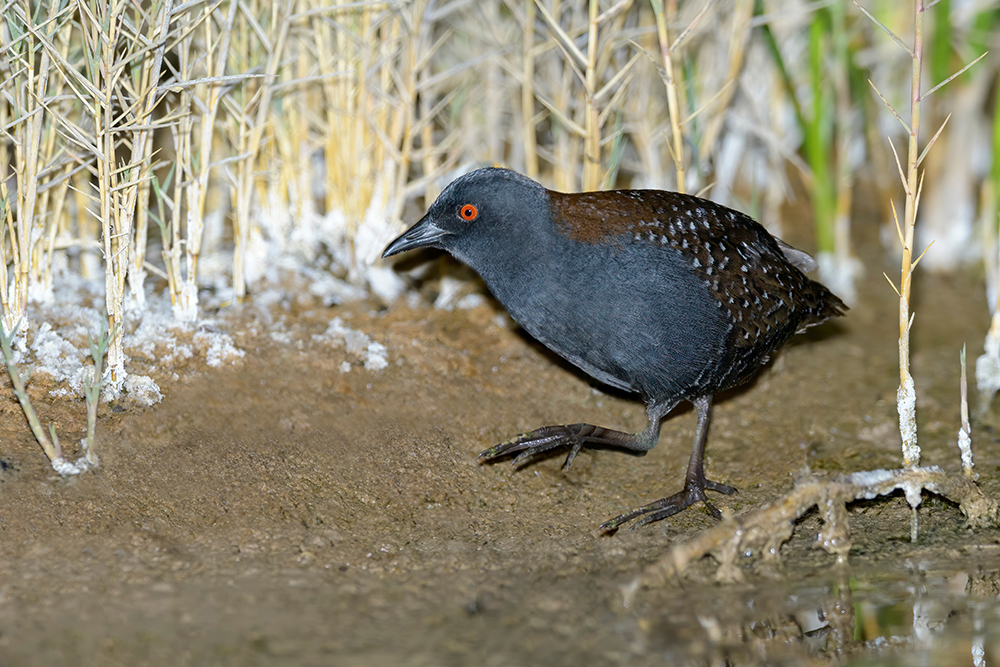Assessing Microtopography with Drones
Understanding the microtopography of Black Rail habitat is critical to the design and creation of new habitat for the species; a difference in just a few centimeters of water can determine whether a Black Rail will use a certain area or avoid it completely. Field work to characterize microtopography and hydrology at a scale relevant to Black Rails is labor intensive, and publicly available Light Detection and Ranging (LiDAR) data do not currently provide fine-enough resolution to measure centimeter-level differences in water levels. Uncrewed Aircraft Systems (UAS, or drones) with LiDAR provide an exciting alternative to capture the centimeter-level differences in elevation relevant to Black Rails. We partnered with Whiteout Solutions, LLC, the Cornell Laboratory of Ornithology, the American Bird Conservancy, and the South Carolina Department of Natural Resources to conduct a pilot project in fall of 2023 to test the use of UAS equipped with LiDAR units to assess Black Rail habitat. We are currently reviewing the results with partners and have also proposed expansion of this work to multiple known Black Rail sites in 2024 (funding pending).
Black Rail Adaptive Management Project
The ACJV and U.S. Geological Survey (USGS), with support from East Carolina University, are engaged with partners in a multi-year collaborative project to develop an adaptive management framework to evaluate two approaches to habitat management for Black Rails. The first approach involves assessing the relative effects of fire and herbicide for reducing woody vegetation and improving Black Rail occupancy. The second assesses the effect of supplemental irrigation on Black Rail occupancy. In 2023, USGS staff completed predictive models that will be used for analyzing the data and presented the models to partners at a workshop in March. Since that time, we’ve been working on standard data collection protocols for partners and have been recruiting partners to conduct management treatments and collect data. Ultimately, this project will improve our understanding of how to implement priority management actions for this species. Interested partners should contact Craig Faulhaber (craig_faulhaber@fws.gov) for more information.
National Monitoring Protocol for eastern Black Rails
There is still much to learn about the distribution and trends for the eastern Black Rail nationally. To address this need, an executive team of Black Rail researchers from across the range of the eastern Black Rail including state, federal, and JV representation formed in 2022 to develop coordinated monitoring protocols for this species. In January 2023 the Eastern Black Rail Call-Response Survey Protocol for Range-Wide Monitoring was finalized and made available for distribution here! In 2024, this group hopes to develop and finalize guidance for spatial distribution of survey locations across the US and at the state level to help better understand this understudied species.
North American Range-wide Black Rail Meeting, FL
ACJV staff helped organize a North American Range-wide Black Rail meeting on October 13th in Fort Lauderdale, Florida. The meeting brought together 34 in-person and 88 virtual participants to share information about conservation actions for the species. Topics included virtual habitat tours across the species’ North American range, prescribed fire, habitat creation, hydrology and microtopography, breeding success and recruitment, and tools for conservation planning. Notes and presentations are available here.
State Guidance Documents
Similar to our effort for Saltmarsh Sparrows, we began meeting with partners in 2023 to identify priority sites and priority site-specific, near-term management actions for Black Rails to help guide funding decisions. We are starting this prioritization process in Florida with a series of partner meetings in 2023 and 2024, and we plan to engage partners in other states in the coming years.

